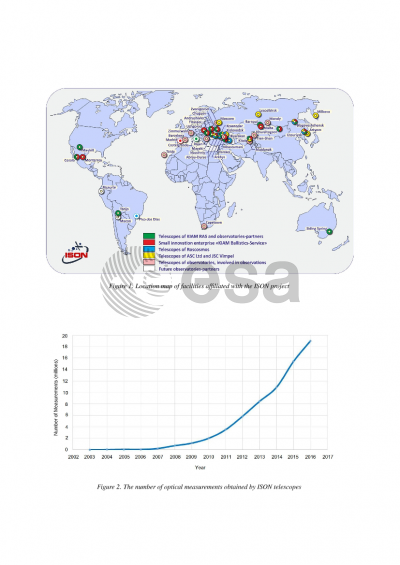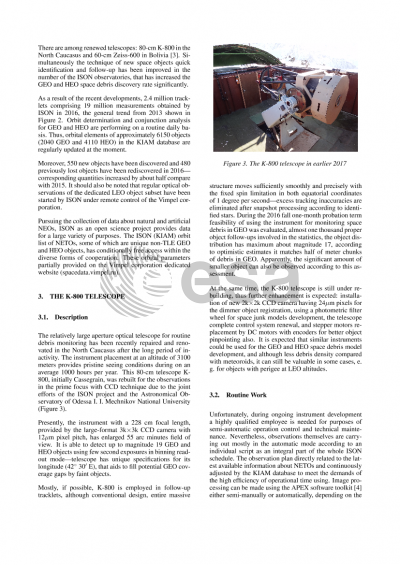Document details

Abstract
While the majority of space debris observations in a low Earth orbit (LEO) occur using radar or lidar facilities, current development of optical system design, detectors and digital image processing enables to indicate substantial advantages in terms of a cost-effective means for monitoring increasing debris population in a geosynchronous orbit (GEO) and a highly elliptical orbit (HEO), using medium aperture ground-based passive optical systems, moreover, previously out-of-use and outmoded instruments could be used for this purpose as well.
The relatively large aperture optical telescope for routine debris monitoring was recently repaired and renovated in the North Caucasus after the long period of inactivity. The instrument placement at an altitude of 3100 meters provides pristine seeing conditions during on an average 1000 hours per year. This 80-?m telescope K-800, initially Cassegrain, was rebuilt for the observations in the prime focus with CCD technique due to the joint efforts of the International Scientific Optical Network (ISON) project and the Russian Academy of Sciences.
Presently, the instrument with a 228 cm focal length, provided by the large-format 3k×3k CCD camera with 12 ?m pixel pitch, has enlarged 55 arc minutes field of view and is able to detect up to 19 magnitude GEO and HEO objects using few second exposures in binning readout mode, telescope has unique specifications for its longitude (42° 30' E), that aids to fill a corresponding GEO coverage gap by faint objects. Mostly, if possible, K-800 is employed in follow-up tracklets, although ordinary design, entire massive structure moves sufficiently smoothly and precisely with the fixed spin limitation in both equatorial coordinates of 1 degree per second – excess tracking inaccuracies are eliminated after snapshot processing according to identified stars. During the 2016 fall one-month probation term feasibility of using the instrument for monitoring space debris in GEO were evaluated, almost one thousand proper object follow-ups involved in the statistics, the object distribution has maximum about 16.5 magnitude, according to optimistic estimates it matches half of meter chunks of debris in GEO, obviously, significant amount of smaller object can also be observed according to this assessment.
At the same time, the K-800 telescope is still under rebuilding, thus further enhancement is expected: installation of new 2k×2k CDD camera having 24 ?m pixels for the dimmer object registration, using a photometric filter wheel for space junk models development and stepper motor replacement by DC motors with encoders for better object pinpointing also. It is expected that corresponding instruments could be used for the HEO space debris model development, and although less debris density compared with meteoroids, it can still be valuable in some cases, e. g. for objects with perigee at LEO altitudes.
Preview





